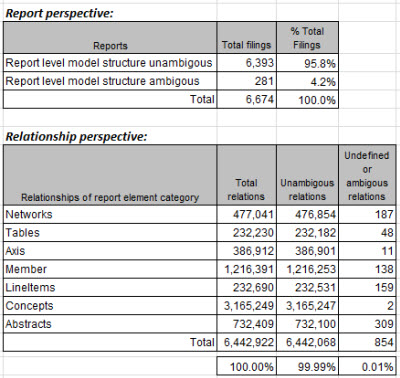Report Level Model Structure Update, Insights Obtained
The latest information on report level model structure greatly improves what was available in my prior analysis. One incredibly insightful and useful thing I was able to achieve is to access every relation between every report element for all 6674 SEC XBRL financial filings analyzed. You can see the details of that analysis here.
One mistake I was making which came to light is that I was evaluating filing rather than actual relations. This is important because while the data shows that 95.8% of SEC XBRL financial filings had unambiguous relations (i.e. if only ONE relation was ambiguous, the ENTIRE REPORT was said to be in error); if you looked at the RELATION LEVEL, 99.9% of the millions of relations were unambiguous.
Here are the report level and the relation level summaries:

Walking through an example is helpful in understanding the report level model structure relations. So consider the information for relations where the parent is an [Axis]. In the graphic below you can see that there are 386,912 [Axis] in the set of 6,674 SEC XBRL financial filings analyzed. As expected, an [Axis] had ZERO Networks as children, ZERO Tables, ZERO Axis, 450,091 Members, ZERO LineItems....BUT HOLD ON...what do we see...11 Concepts as children of an Axis! What is up with that?

The point here is that an [Axis] has Members, which is defined as a report element with a type attribute equal to 'nonnum:domainItemType', as children, nothing else. What does it mean if a Concept is a child of a Member? Concepts are used to report facts. Members are used to describe the value of an Axis. Concepts are not intended as children of an Axis. So, how should this be interpreted?
Below is a summary of the 14 most potentially ambiguous relations found in a set of 6,674 analyzed SEC XBRL financial filings. Of the 6,442,922 relations in SEC XBRL financial filings, a total of only 344 relations were deemed odd and the interpretation of their relationships was ambiguous:
- 1 SEC filers have an [Axis] as the child of a Network.
- 3 SEC filers have a [Member] as the child of a Network. [Member]s are generally children of an [Axis] or another [Member]
- 1 SEC filer has a [Table] that is the child of another [Table]. What is the meaning of this?
- 25 SEC filers have a Concept as a child of a [Table]. [Table]s generally have [Axis] and [LineItems] as children. What does it mean if a Concept is a child of a [Table]?
- 22 SEC filers have an [Abstract] as a child of a [Table]. [Table]s generally have [Axis] and [LineItems] as children. What does it mean if an Abstract is a child of a [Table]?
- 11 SEC filers have a Concept which is a child of an [Axis]. Only [Member]s should be children of an [Axis]
- 137 SEC filers have a Concept which is the child of a [Member]. Generally [Member]s are the only children of other [Member]s
- 1 SEC filer has an Abstract as the child of a [Member]. Generally [Member]s are the only children of other [Member]s
- 45 SEC filers have a [Table] as a child of a set of [LineItems]. Generally [LineItems] are children of [Table]s, not the other way around.
- 3 SEC filers have an [Axis] which is child of a set of [LineItems]s. Generally Concepts and [Abstract]s are found in 99.99% as children of a LineItems of SEC filings.
- 1 SEC filer had a [Member] which is the child of a Concept. How should this be interpreted?
- 2 SEC filers had [LineItems] which were the child of a Concept. How should this be interpreted?
- 20 SEC filers had an [Axis] which is the child of an [Abstract]. How should this be interpreted?
- 72 SEC filers had a [Member] as the child of an [Abstract]. How should this be interpreted?
There are other illegal and odd relationships. For example, while 99.4% of Networks have a root child concept report element which is of the category Abstract; a handful use a Table as the root element (1261), or a Concept (46). This may not be ambiguous. But 183 use LineItems as the root concept. LineItems are general used within a Table, but again; the information might not be ambiguous. But 1 SEC filing as an [Axis] as the root and 3 have a Member as a root. What the heck does that mean?
The point is that while there are 817 anomalies, the 344 relations summarized above are the most odd. However, it would be better if none of the 817 issues existed.
Identifying these report level model structure relations and attempting to extract this information from SEC XBRL financial filings provide a number of noteworthy insights:
- Insight #1: The report elements which make up an SEC XBRL financial filing can be grouped into categories: Network, Table, Axis, Member, LineItems, Concept, Abstract. This report element categories have relations with other report element categories. The vast majority of relations between report elements in SEC XBRL financial filings, 99.9%, and the vast majority of filings themselves, 95,8% of all such filings, follow these relations.
- Insight #2: Not following these report level model structure relations leads to potentially ambiguous representations of such digital financial filings.

Reader Comments